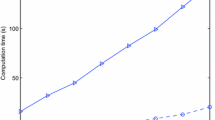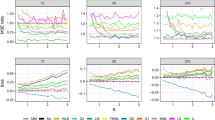Abstract
In this paper, we propose a smoothed estimating equation for the difference of quantiles with two samples. Using the jackknife pseudo-sample technique for the estimating equation, we propose the jackknife empirical likelihood (JEL) ratio and establish the Wilk’s theorem. Due to avoiding estimating link variables, the simulation studies demonstrate that JEL method has computational efficiency compared with traditional normal approximation method. We carry out a simulation study in terms of coverage probability and average length of the proposed confidence intervals. A real data set is used to illustrate the JEL procedure.

Similar content being viewed by others
References
Baysal, E., Staum, J. (2008). Empirical likelihood for value-at-risk and expected shortfall. Journal of Risk, 11, 3–32.
Chen, J., Peng, L., Zhao, Y. (2009). Empirical likelihood based confidence intervals for copulas. Journal of Multivariate Analysis, 100, 137–151.
Chen, S., Hall, P. (1993). Smoothed empirical likelihood confidence intervals for quantiles. Annals of Statistics, 21, 1166–1181.
Csörgo, M. (1987). Quantile processes with statistical applications. Philadelphia, PA: SIAM Publications.
Gong, Y., Peng, L., Qi, Y. (2010). Smoothed jackknife empirical likelihood method for ROC curve. Journal of Multivariate Analysis, 101, 1520–1531.
Jing, B.-Y., Yuan, J., & Zhou, W. (2009). Jackknife empirical likelihood. Journal of the American Statistical Association, 104, 1224–1232.
Kosorok, M. (1999). Two-sample quantile tests under general conditions. Biometrika, 86, 909–921.
Miller, R. G. (1974). The jackknife: a review. Biometrika, 61, 1–15.
Owen, A. (1988). Empirical likelihood ratio confidence intervals for a single functional. Biometrika, 75, 237–249.
Owen, A. (1990). Empirical likelihood and confidence regions. Annals of Statistics, 18, 90–120.
Owen, A. (2001). Empirical likelihood. New York: Chapman & Hall.
Qin, J., Lawless, J. (1994). Empirical likelihood and general estimating equations. Annals of Statistics, 22, 300–325.
Reiss, R. D. (1989). Approximate distributions of order statistics. New York: Springer.
Sheather, S., Marron, J. (1990). Kernel quantile estimators. Journal of the American Statistical Association, 85, 410–416.
van der Vaart, A. W., (2000). Asymptotic Statistics. Cambridge, UK: Cambridge University Press.
Wang, R., Peng, L., Qi, Y. (2013). Jackknife empirical likelihood test for equality of two high-dimensional means. Statistica Sinica, 23(2), 667–690.
Yang, H., Zhao, Y. (2013). Smoothed jackknife empirical likelihood inference for the difference of ROC curves. Journal of Multivariate Analysis, 140, 270–284.
Yang, H., Zhao, Y. (2015). Smoothed jackknife empirical likelihood inference for ROC curves with missing data. Journal of Multivariate Analysis, 115, 123–138.
Zhou, W., Jing, B.-Y. (2003). Adjusted empirical likelihood method for quantiles. Annals Institute of Statistical Mathematics, 55, 689–703.
Acknowledgments
This research was supported by National Natural Science Foundation of China (No. 11501567). Yichuan Zhao acknowledges the support from the NSF Grant (DMS-1406163) and NSA Grant (H98230-12-1-0209). The authors would like to thank an associate editor, the two referees for the helpful comments, which has improved the quality of the paper significantly.
Author information
Authors and Affiliations
Corresponding author
Appendix: Proofs of Theorems
Appendix: Proofs of Theorems
Proof of Theorem 1
We can decompose \(\Pi _{m ,n}\{p,\theta (p)\}\) as
where
The Eq. (3) is simplified as follows
The above equation is obtained by the Glivenko–Cantelli Theorem of \(F_1\) and the bounded derivative of \(D\{\theta (p), p\}=F_1\{F_2^{-1}(p)+\theta (p)\}\). By Eqs. (10) and (11) in Gong et al. (2010), we can extend their result in our case, i.e., \(\Pi _{m}\{p,\theta (p)\}-\Pi _{m,n}\{p,\theta (p)\}=o_p(1)\). Thus, considering Eqs. (3) and (4), we finish the proof about
\(\square \)
Proof of Theorem 2:
One has that
For the first term of (6), one has
where \(W_{F_1}(t)=\sqrt{m}\{F_{m,1}(t)-F_{1}(t)\}\). Because of the symmetric property of kernel function, the second term of (7) is equal to zero.
By arguments in pp. 266 and 269 in van der Vaart (2000), the weak convergence of \(F_{m,1}(x)\) and \(F_{n,2}(x)\) is true.
where \(B_{1}(\cdot )\) and \(B_{2}(\cdot )\) are two independent Brownian bridge on [0, 1]. Thus, \(B_{1}(F_1(x))\) and \(B_{2}(F_2(x))\) are independent. Due to the Donsker theorem and similar proofs for equation 9 in Gong et al. (2010), \(I\overset{\mathfrak {D}}{\longrightarrow }B_1(F_1\{F_2^{-1}(p)+\theta (p)\})\). Using \(F_1^{-1}(p)=F_2^{-1}(p)+\theta (p)\), it is clear that
For the second term of Eq. (6), under condition C.1, we adopt the procedure similar to that in Gong et al. (2010),
where \(W_{F_2}(t)=\sqrt{n}\{F_{n,2}(t)-F_{2}(t)\}\). Combining (7), (8), (9) and the independence of \(B_1(F_1(x))\) and \(B_2(F_2(x))\), one has that
\(\square \)
Before we prove Theorem 3, we need to obtain the asymptotic normality of jackknife estimator and the consistency of jackknife variance estimator. Those asymptotic properties are given in Lemmas 1 and 2.
Lemma 1
Suppose conditions C.1–C.4 hold. We have
where \(\sigma ^{2}(p)\) is defined in Theorem 2.
Proof of Lemma 1:
First, we introduce some properties of \(F_{n,2,-i}\) as follows:
and
because
For the pseudo-sample, based on equation (16) in Gong et al. (2010) and Eqs. (11) and (12), one has that
Using (10) and (13), it is clear that
\(\square \)
In order to obtain the Wilks’ theorem for the JEL procedure, we need to check the consistency of jackknife pseudo-sample variance in addition to Eq. (14). Define the pseudo-sample variance
Lemma 2
Under the conditions C.1–C.4, one has that
Proof of Lemma 2:
For \(1\le i\le m\),
and
By the similar argument in Gong et al. (2010), one has
For \(m+1\le i\le m+n\), one has that
and
Under condition C.1, we follow the argument which is similar to Gong et al. (2010),
Thus, based on Eqs. (15) and (16),
\(\square \)
Proof of Theorem 3:
Combining Lemmas 1 and 2, we can easily prove Theorem 3 by the standard arguments in Owen (1990). The details of the proof are omitted. \(\square \)
About this article
Cite this article
Yang, H., Zhao, Y. Smoothed jackknife empirical likelihood for the difference of two quantiles. Ann Inst Stat Math 69, 1059–1073 (2017). https://doi.org/10.1007/s10463-016-0576-7
Received:
Revised:
Published:
Issue Date:
DOI: https://doi.org/10.1007/s10463-016-0576-7




